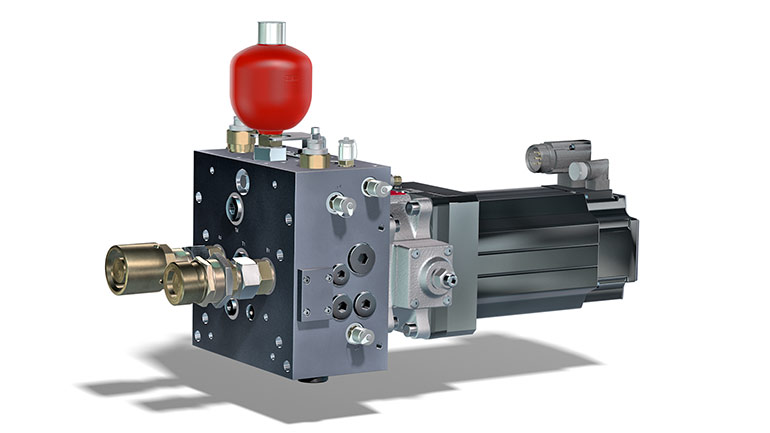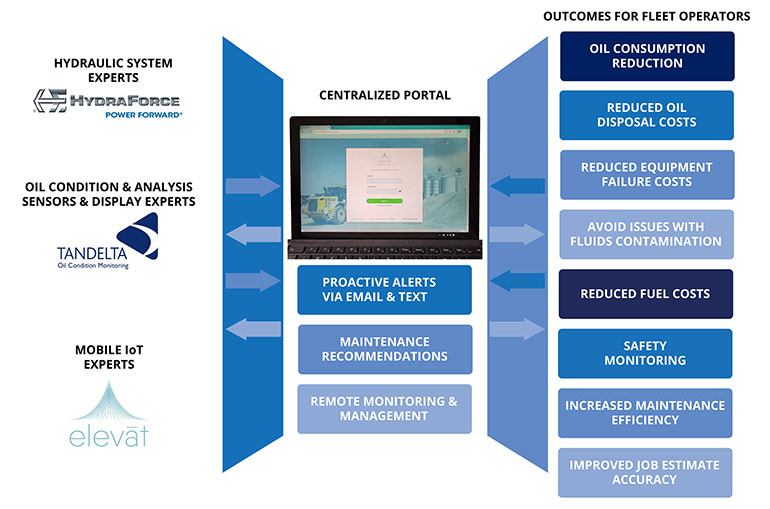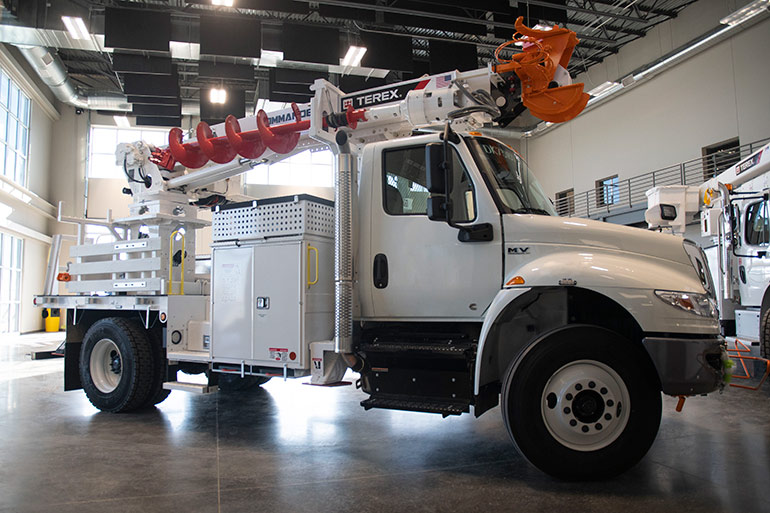From mobile electrification to telematics and IoT, modern utilities equipment is becoming more controllable and smarter for efficient and reliable designs.
By Josh Cosford, Contributing Editor
The most conspicuous trend in the utility equipment industry — as with most mobile machinery — is electrification. Electrification of mobile machinery previously referenced electric control through solenoid or proportional valves. However, at the Work Truck Show last year, at least a dozen fully electric vehicles with high capacity batteries and electric motor drives were on display. While no one exhibitor showed us what an all-electric vehicle looks like for the utility industry, the trend is clear.
So, what does the electrification of utility equipment have in store for hydraulics? Well, you can bet electric actuator manufacturers have hydraulics in their sights, but we’re still a long way from ball screws completely replacing hydraulic cylinders on mobile machinery. At the same time, electrical influence over hydraulics will continue to increase even while hydraulics continues to shine with its superior power density. Fluid power systems will continue to adopt Industry 4.0 solutions such as data and telematics. In contrast, engineers continue to raise the pressure bar (no pun intended) of pumps, valves and actuators to leave electrics no chance of matching its power.
Electrohydraulic actuation
Aside from the integration of Industry 4.0 technologies, the bespoke and clever combination of integrated components offer unique ways for designs to take advantage of the coming tide of electrical power capacity while still offering the strength and reliability of hydraulics. These self-contained electro-hydraulic actuators require only an electrical power source alongside electronic control.

Imagine a hydraulic cylinder with a compact hydraulic power unit attached directly to its head or cap, and you have yourself an electrohydraulic actuator. The Moog Inc. Electrohydrostatic Pump System (EPS) consists of an Electrohydrostatic Pump Unit (EPU) and a standardized manifold with hydraulic accumulator. It is offered as a complete system without an actuator and can be easily integrated into machine concepts, whether retrofit or new developments.
Optimal design of the system peripherals can reduce the size and power of electronic components thus the connected load. In combination with an intelligent energy management system, this leads to significant savings in total energy consumption in the medium to long term. Moog offers a wide range of suitable power electronics and software solutions to exploit this potential.
Electrohydraulic actuator technology is still relatively new and could benefit from further development and integration. Current versions still looked pieced together like mini power units attached to a cylinder – clearly an assembly of various parts. However, we must imagine entirely self-contained units powering booms, buckets, knuckles and attachments with only electrical connections exposed to the world. The actuators will carry considerably more bulk than a simple hydraulic cylinder. This bulk will increase the diameter and retracted length of the unit but offer all the benefits of this modular design.
Imagine using the same chassis for a nearly infinite combination of cranes, digger derricks, bucket booms or any other hydraulically controlled function best suited for utility machinery. There would be no need to change the pump or valve package to suit different machines but instead, simply choose the actuator with the force, velocity and stroke required for the application.
When perfected, the electrohydraulic actuator will see the electric motor contained within the “barrel” driving a pump housed directly into the cylinder cap. Some accessory valves screwed directly into the cap will complement the application requirements, although even more sophisticated versions may use linear, pressure and flow transducers to create a closed-loop PID control of the actuator where the bi-rotational servo motor rotates only as required.
The advantages to the electrohydraulic actuator are more than the easy-to-use modular nature. No continuously rotating central prime mover has to rotate the hydraulic pump to satisfy the pressure and speed demand of any given actuator at any given time. Inactive functions simply remain idle to save power. Rather than running a piston pump on standby, control functions turn on and stroke the actuators individually. A minor correction in a bucket boom position may require just one actuator to move. However, that single actuator will use fractional horsepower compared to conventional centralized prime movers.
Another benefit to the electrohydraulic actuator is the lack of hoses and plumbing — being self-contained, no hoses, fittings or adapters need plumbing around and through the machine. Only wiring needs routing throughout the machine, although its size tends to be much smaller than hoses and may remain mostly contained within the channels of booms and beams. Imagine a hydraulic machine no longer sidelined by a simple hydraulic hose failure.
Telematics keeps an eye of key data
Other recently futuristic technologies have become commonplace in utility equipment in just a few short years. One such technology is telematics, which is a sophisticated technology that monitors critical machine performance, reliability, location, maintenance, and other parameters while transmitting those data to remote workstations or devices, such as PC’s or mobile phones.
The collection and analysis of data is one of the tenets of Industry 4.0 and provides fleet operators with powerful information on the status of their vehicles. Productivity, safety, optimization, sustainability, and reliability improve when machine data is collected, analyzed, and relayed. A telematics device, much like a black box, may connect directly to a vehicle’s OBD port to pick up on factory sensors but also install and track data from other machine controllers or individual sensors.
Hydraulic oil performance makes an easy target for telematics, tracking tank level, temperature, and pressure to convey system health to the machine operator directly or the fleet manager remotely. Controllers also monitor and collect data for maintenance purposes, such as filter differential pressure, oil total-acid number, pump vibration and case drain flow, providing the maintenance team with estimates on lifespan or imminent failure.

Recently, HydraForce, Tan Delta Systems and Elevāt partnered to help eliminate the most common causes of off-highway machine downtime. The modern mobile machine telematics solution from Elevāt seamlessly incorporates with manifold assemblies using HydraForce cartridge valves and Tan Delta state-of-the-art oil conditioning sensors. The integrated solution provides a centralized portal along with email and text alerts providing fleet operators with remote monitoring, control, and optimization capabilities for field-deployed assets.
“Through accurate monitoring of oil health, maintenance scheduling can also be optimized as equipment is serviced only when required, and operators can rest assured that any unexpected changes in the oil condition will be immediately detected and reported. This can also extend the operational life of equipment and overall machine health, as optimal oil conditions prevent unnecessary wear and tear,” said Chris Greenwood, managing director at Tan Delta Systems.
The Tan Delta sensor works by providing a full-spectrum holistic (FSHTM) oil quality analysis, which continuously monitors the ratio of two key measurements, capacitance and conductance, to provide a real-time measurement (permittivity). This sensor technology enables users to observe any changes within the oil composition, including signs of contamination or abnormalities in the oil chemistry.
“By combining the electronic controller architecture with telematics, users will have access to real-time data and ongoing alerts of oil conditions,” said Jason Sharpe, Tan Delta Systems. “This will help prevent excessive wear of hydraulic components and catastrophic failures that can occur when machines are in operation, resulting in increased productivity and reduced machine downtime and maintenance costs.”
Additionally, as part of the Elevāt IoT subscription with HydraForce, operators use an application that can be paired with the Tan Delta oil conditioning sensor. This application will visualize data and provide customized alerts to inform the operator or owner when hydraulic fluids require maintenance.
Knowing utility vehicles’ location and work rate allows the fleet manager to optimize schedules, better plan tasks, and increase productivity. Knowing that Operator Team A, running Truck 26, can replace 2.3 utility poles per day while Operator Team B, running Truck 20, can only replace 1.7 utility poles per day provides valuable insights. Training for Team B or improvements to Truck 20 will increase productivity and optimize schedules. In some cases, perhaps also observing vehicle locations via GPS will elucidate team member behavioral concerns, such as extended breaks or unscheduled stops.
You’ve likely experienced the influence of telematics first-hand. For example, previously, a call to your cable company to replace a downed line after a storm might yield an appointment scheduled sometime between Tuesday 8 AM to 4 PM. However, improvements in data collections and analytics now provide you with a more concisely scheduled time frame, such as 8-10 AM, but then also trigger an automated phone call when GPS tracks the driver at fifteen minutes away from your location.
One machine that does many jobs
Another method to optimize a fleet is the inclusion of more flexible machinery. Previously, machinery dedicated to its function were staples in every fleet – bucket booms, digger/derricks and service trucks may all have been required on-site at a specific job. Combining these functions into one truck better utilizes manpower and capital to provide a single machine for a single team to perform most jobs.

The Digger Derrick with Bucket offers a new standard to fill the garages of utility fleets. Teams arrive on sight ready to remove a utility pole, first preparing and disconnecting the lines before removing the pole. Next, the hole is augured (hydraulically, of course) before reinstallation of the pole using the special attachment at the end of the derrick. Then, once erect, the bucket lifts the team back up to finish the job with the lines. The vehicle uses all available space, and all the bins and storage of a service body truck find themselves available for the tools, clamps and straps required for the job.
As urban boundaries grow, the fleets of municipalities, telecom and other utility providers will continue to advance to support the population’s needs. With that growth, fleets must become more efficient, powerful, reliable and flexible, including the hydraulic systems used to achieve those goals.
Filed Under: Engineering Basics, Mobile Hydraulic Tips, Trending